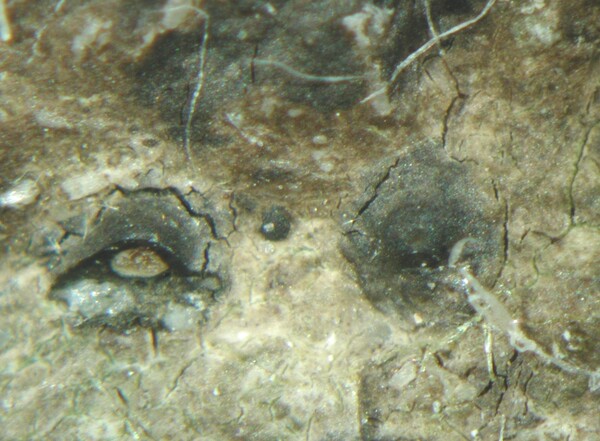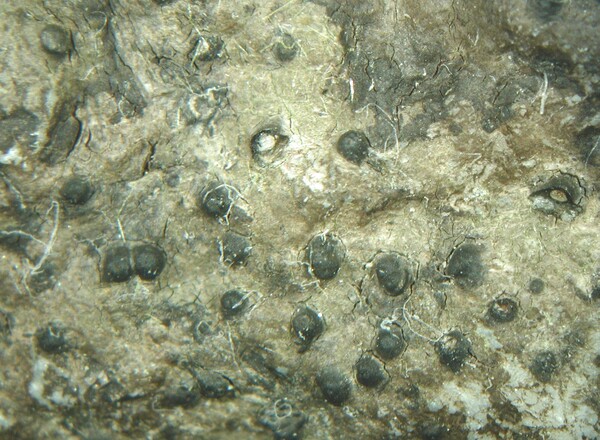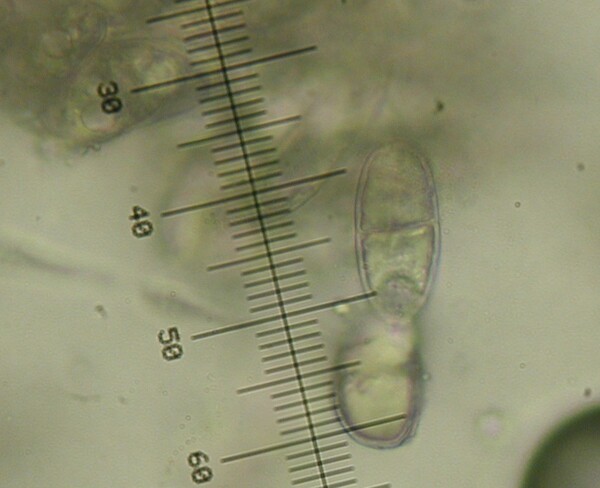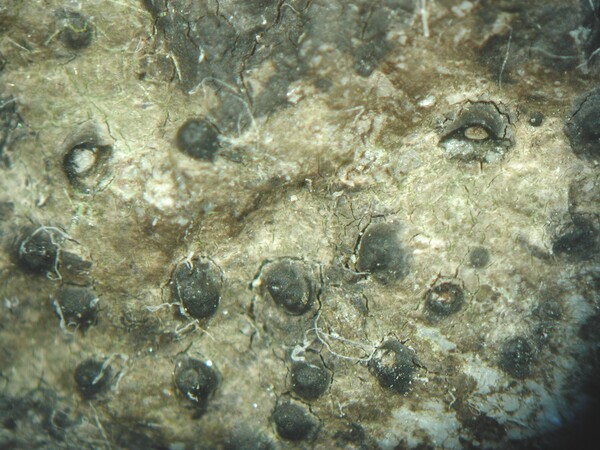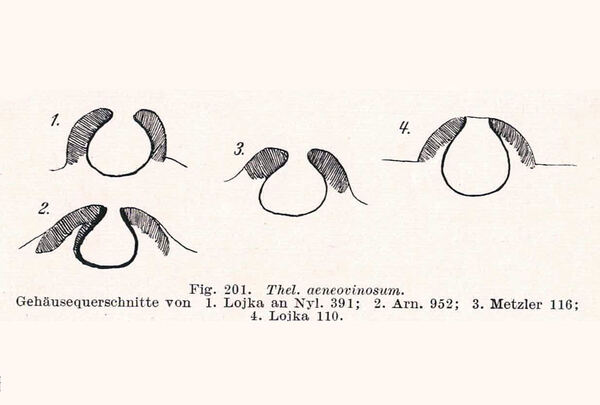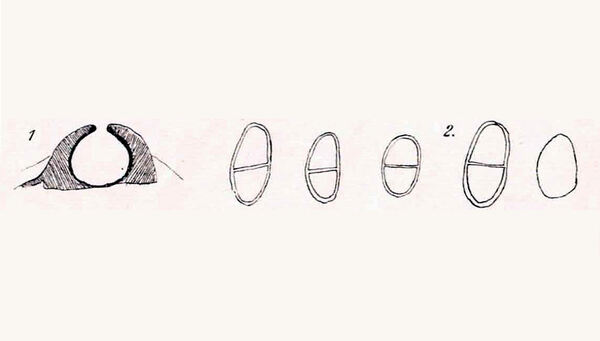Thelidium methorium (Nyl.) Hellb.
Öfvers. K. Svensk. Vetensk.-Akad. Förh., 32, 3: 80, 1875. Basionym: Verrucaria methoria Nyl. - Öfvers. K. Svensk. Vetensk.-Akad. Förh., 17: 296, 1860.
Synonyms: Involucrothele aeneovinosa (Anzi) Servít; Involucrothele kutakii (Servít) Servít; Sagedia aeneovinosa Anzi; Thelidium aeneovinosum (Anzi) Arnold; Thelidium aeneovinosum var. kutakii Servít; Thelidium diaboli A. Massal.; Thelidium kutakii (Servít) Servít
Distribution: N - Frl (Tretiach & Hafellner 2000), TAA (Thüs & Nascimbene 2008, Nascimbene & al. 2022), Lomb (Thüs & Nascimbene 2008), Piem (Isocrono & al. 2004), Lig.
Description: Thallus crustose, episubstratic, black-brown, grey or reddish brown, thin to thick, continuous or finely rimose, paraplectenchymatous, more or less subgelatinous and with transparent margins when wet, sometimes delimited by a black line. Cortex indistinct or consisting of an algal-free layer which may be brown in sun-forms. Perithecia black to brownish grey, forming distinct projections, (0.3-)0.4-1(-1.6) mm across, naked at least in upper half. Involucrellum well-developed, moderately thick (<90 μm in upper third), often reaching the base of exciple; exciple almost colourless to brown or green-brown, K+ greenish brown to green; hamathecium of periphyses and periphysoids, interascal filaments absent; periphyses to 60 μm long; hymenial gel I+ red (I+ blue at very low concentrations of I), K/I+ blue. Asci 8-spored, ellipsoid to clavate, I-, fissitunicate, the wall thickened above, with an ocular chamber, dehiscent by extrusion of a delicate rostrum. Ascospores 1-septate, hyaline, ellipsoid, (24-)30-38(-49) x (10-)13-17(-21) μm. Photobiont chlorococcoid. Spot tests: K-, C-, KC-, P-, UV-. Chemistry: without lichen substances.
Note: an arctic-alpine to boreal-montane, probably circumpolar lichen found on periodically submerged siliceous rocks in Alpine to montane creeks.
Growth form: Crustose
Substrata: rocks
Photobiont: green algae other than Trentepohlia
Reproductive strategy: mainly sexual
Periodically submerged (e.g. in creeks)
Commonnes-rarity: (info)
Alpine belt: rare
Subalpine belt: rather rare
Oromediterranean belt: absent
Montane belt: rare
Submediterranean belt: absent
Padanian area: absent
Humid submediterranean belt: absent
Humid mediterranean belt: absent
Dry mediterranean belt: absent
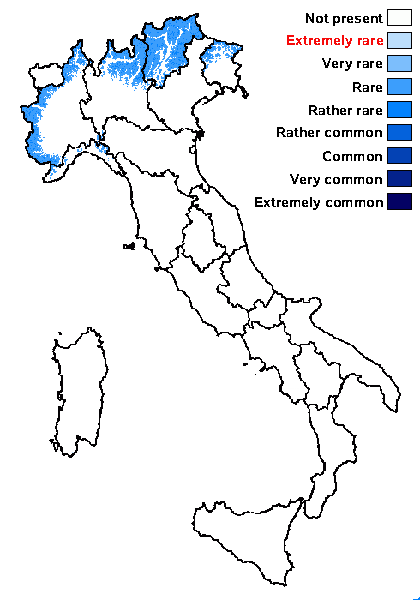
Predictive model
Herbarium samples
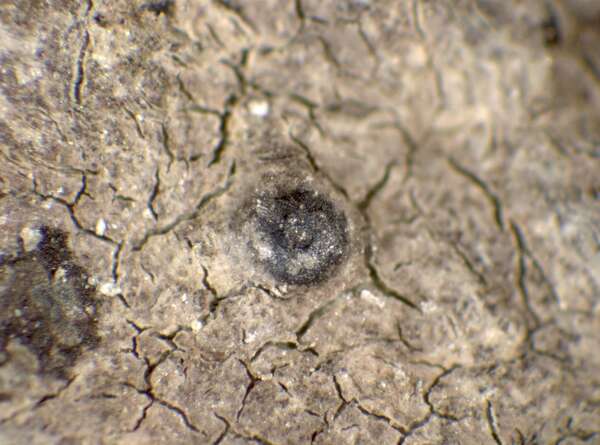

P.L. Nimis; Owner: Department of Life Sciences, University of Trieste
Herbarium: TSB (21026)
2001/12/12
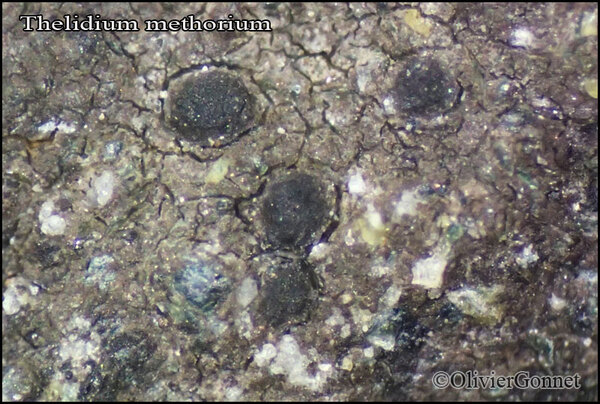
Courtesy Danièle et Olivier Gonnet - Source: https://www.afl-lichenologie.fr/Photos_AFL/Photos_AFL_T/Textes_T2/Thelidium_methorium.htm
France, 25/8/2018 - Col du Petit Mont Cenis, alt. 2200 m - Savoie

Courtesy Danièle et Olivier Gonnet - Source: https://www.afl-lichenologie.fr/Photos_AFL/Photos_AFL_T/Textes_T2/Thelidium_methorium.htm
France, 25/8/2018 - Col du Petit Mont Cenis, alt. 2200 m - Savoie

Courtesy Danièle et Olivier Gonnet - Source: https://www.afl-lichenologie.fr/Photos_AFL/Photos_AFL_T/Textes_T2/Thelidium_methorium.htm
France, 25/8/2018 - Col du Petit Mont Cenis, alt. 2200 m - Savoie
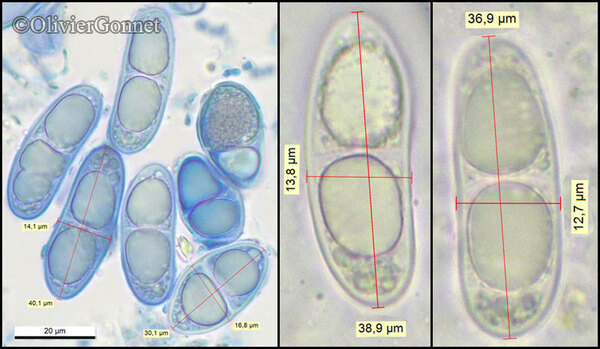
Courtesy Danièle et Olivier Gonnet - Source: https://www.afl-lichenologie.fr/Photos_AFL/Photos_AFL_T/Textes_T2/Thelidium_methorium.htm
France, 25/8/2018 - Col du Petit Mont Cenis, alt. 2200 m - Savoie
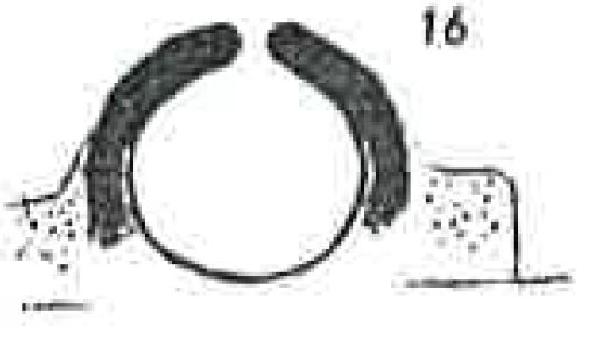
Source: Servit, M 1955: Nove lisejniky. Lichenes novi. - Rozp. Ceskoslov. Acad. Ved 65(3): 1-45. - Public Domain
as Involucrothele methoria
Growth form: Crustose
Substrata: rocks
Photobiont: green algae other than Trentepohlia
Reproductive strategy: mainly sexual
Periodically submerged (e.g. in creeks)
Commonnes-rarity: (info)
Alpine belt: rare
Subalpine belt: rather rare
Oromediterranean belt: absent
Montane belt: rare
Submediterranean belt: absent
Padanian area: absent
Humid submediterranean belt: absent
Humid mediterranean belt: absent
Dry mediterranean belt: absent

Predictive model
| Herbarium samples |


P.L. Nimis; Owner: Department of Life Sciences, University of Trieste
Herbarium: TSB (21026)
2001/12/12

Courtesy Danièle et Olivier Gonnet - Source: https://www.afl-lichenologie.fr/Photos_AFL/Photos_AFL_T/Textes_T2/Thelidium_methorium.htm
France, 25/8/2018 - Col du Petit Mont Cenis, alt. 2200 m - Savoie

Courtesy Danièle et Olivier Gonnet - Source: https://www.afl-lichenologie.fr/Photos_AFL/Photos_AFL_T/Textes_T2/Thelidium_methorium.htm
France, 25/8/2018 - Col du Petit Mont Cenis, alt. 2200 m - Savoie

Courtesy Danièle et Olivier Gonnet - Source: https://www.afl-lichenologie.fr/Photos_AFL/Photos_AFL_T/Textes_T2/Thelidium_methorium.htm
France, 25/8/2018 - Col du Petit Mont Cenis, alt. 2200 m - Savoie

Courtesy Danièle et Olivier Gonnet - Source: https://www.afl-lichenologie.fr/Photos_AFL/Photos_AFL_T/Textes_T2/Thelidium_methorium.htm
France, 25/8/2018 - Col du Petit Mont Cenis, alt. 2200 m - Savoie

 INDEX FUNGORUM
INDEX FUNGORUM
 GBIF
GBIF
 DOLICHENS
DOLICHENS

